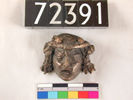


European theatre traces its roots to ancient Greek theatre, with architectural, literary and religious presence. From the fifth century BC, ancient Greek cities staged tragedies, comedies, or shorter satyr plays, composed specially for dramatic performance in specific festivals (religious time) and in specific theatres (religious-civic architecture), with fixed conventions for main characters, chorus, manner of delivery, plot. Among the most famous Attic tragedians are Aeschylus, Sophocles, and Euripides, and among the most famous Attic comedians is Aristophanes.
In Egypt, Greek theatre arrived as part of the general Hellenisation of Egypt following the conquest of the country by Alexander the Great (332 BC). One of the earliest Greek papyri from Egypt preserves part of a play called The Persians, by Timotheus of Miletus (Papyrus Berlin 9875, from a tomb at Abusir, second half of the fourth century BC). The numerous papyri preserved in cartonnage mummy covers include dramatic excerpts: for example, the papyri extracted from cartonnage found by Petrie at Gurob includes a small fragment of a comedy, copied in the mid third century BC (UC 31915: Handley 1988). The comedies by the popular fourth century BC playwright Menander survive mainly in Ptolemaic and Roman Period papyri from Egypt, relatively extensive in comparison with the short selected sayings preserved among Byzantine manuscripts.
 |
 |
 |
Hellenistic, particularly Alexandrian, art abounds in the motifs of the Greek theatrical tradition, such as the distinctive stylized masks worn by actors in tragedy and comedy. However, there is no Ptolemaic theatre building preserved in Egypt. Excavations have revealed great theatres in the architecture of the Roman Period, at Alexandria, and Oxyrhynchus. The theatre portico at Antinoopolis is one of the magnificent Roman monuments of that city recorded by the French military expedition of 1798-1801, but destroyed in early 19th century industrialisation.
Petrie estimated that the theatre at Oxyrhynchus could hold 11,000 spectators. This compares with an estimated audience size of about 2000 for the only Roman theatre excavated in England, at St Albans (Verulamium). In the first century AD the ancient Roman author Pliny gave the seating capacity of the great Theatre of Pompey at Rome as 40,000, though this has been reestimated to about 10,000 from the remains. Whatever its place in the league table of ancient theatres, the Oxyrhynchus monument was clearly of exceptional scale for a provincial city of the Empire; the pre-Roman and then the Byzantine history of the theatre, its origin and its demise, remain unknown.
No specific architecture has been identified in ancient Egypt for performance of literary compositions. There remains intense debate over the use of the terms 'theatre', 'drama', and even 'performance' in Egyptology (Mikhail 1984). The following observations may be used for debating the question:
The Verhoeven interpretation of the Tale of Horus and Seth carries implications of the greatest importance for the modern reception of literary compositions: in formal features such as layout, Papyrus Chester Beatty 1 does not present the Tale as a ritual, and is indistinguishable from literary manuscripts bearing non-religious compositions such as teachings and narrative tales without deities. If that papyrus acted as a platform for recitation in a ritual, performace may be far more deely embedded in the ancient employment of literary manuscripts bearing such compositions as the Tale of the Shipwrecked Sailor, the Tale of Sanehat or the Teaching of Ptahhotep.
There is place for performance outside the research debate the relation between ancient Egyptian literature and ancient Greek theatre, or the theatrical aspects of ancient Egyptian literary compositions. Modern performance may be used both as a means of access to ancient literature, and as a research tool in exploring individual compositions. On Digital Egypt for Universities there are translations of selected ancient writings; for a few short passages there are also audio renderings of the English translation and of the original language consonants, using a variety of different voices to explore the relation between individual reader and writing, and between individual hearers and readings. Other media may be enlisted to pursue the different dimensions of literary and religious writing: readings, dramatic performance in different cultural traditions, and short films offer varied paths into the written sources of another culture.
Copyright © 2003 University College London. All rights reserved.